Abstract
The relationship between early and late epicardial electrocardiographic changes as well as those in regional myocardial blood flow (MBF) and the severity of myocardial damage was determined in 12 anesthetized dogs with left anterior descending coronary artery ligation. Radioactive microspheres (15 mum) were used to measure regional MBF at 15 min (early) and 24 h (late) after coronary occlusion. Severity of myocardial damage was assessed by the extent of myocardial creatine phosphokinase depletion 24 h after coronary ligation. There was a close linear correlation between myocardial creatine phosphokinase activity and regional MBF both early (r=0.93, 2P less than 0.001) and late (r=0.88, 2P less than 0.001). An inverse but less precise relationship existed between acute epicardial ST-segment elevation and early (r=-0.41, 2P less than 0.001), or late (r=0.35, 2P less than 0.05) regional MBF. Similarly, a weak correlation was found between myocardial creatine phosphokinase (IU/mg protein) at 24 h and early epicardial ST (millivolt) elevation (r=-0.36, 2P less than 0.02). In the center zones of the infarct with MBF 1/10 of normal, about 35% of the areas with normal QRS width had no epicardial ST-segment elevation 15 min after coronary occlusion. About 44% of the areas which developed pathological Q-waves in the electrocardiogram at 24 h had no ST elevation 15 min after coronary ligation. Late evolution of abnormal Q-waves occurred almost invariably in areas in which the early MBF was reduced to less than 50% of normal and in areas which subsequently had myocardial creatine phosphokinase levels reduced to less than 60% of normal. After coronary occlusion, the severity of the ultimate myocardial damage, which was directly proportional to the degree of reduction in MBF, was therefore not reliably predicted by the early epicardial ST-segment elevation. The data obtained in these studies suggest the need for caution in the use of acute ST-segment elevation as a predictive index of the extent or severity of myocardial ischemic damage.
Full text
PDF
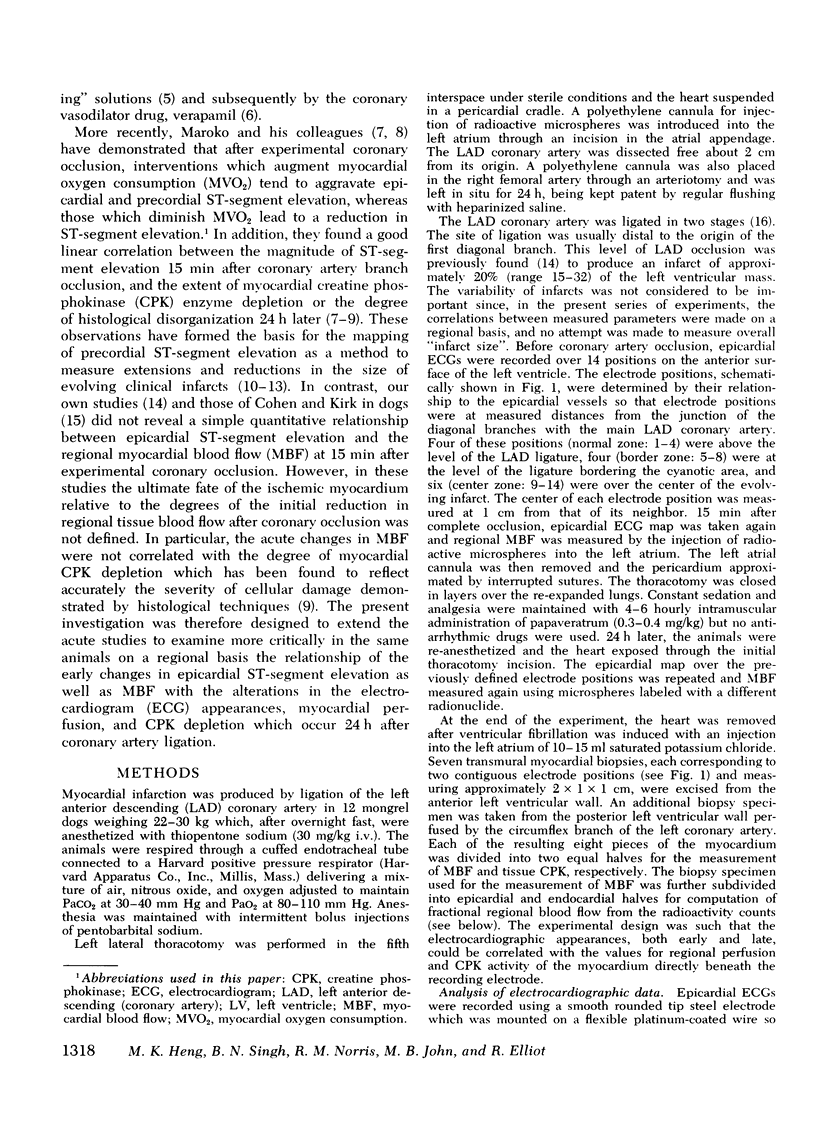
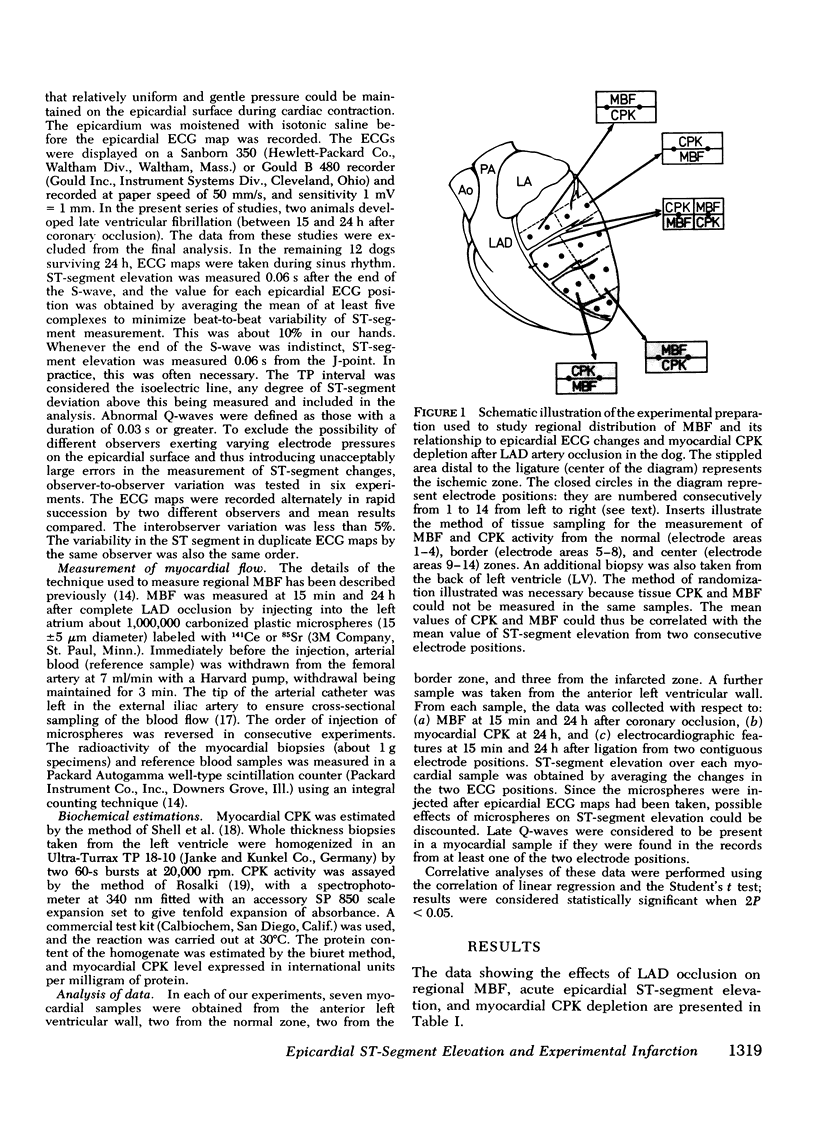
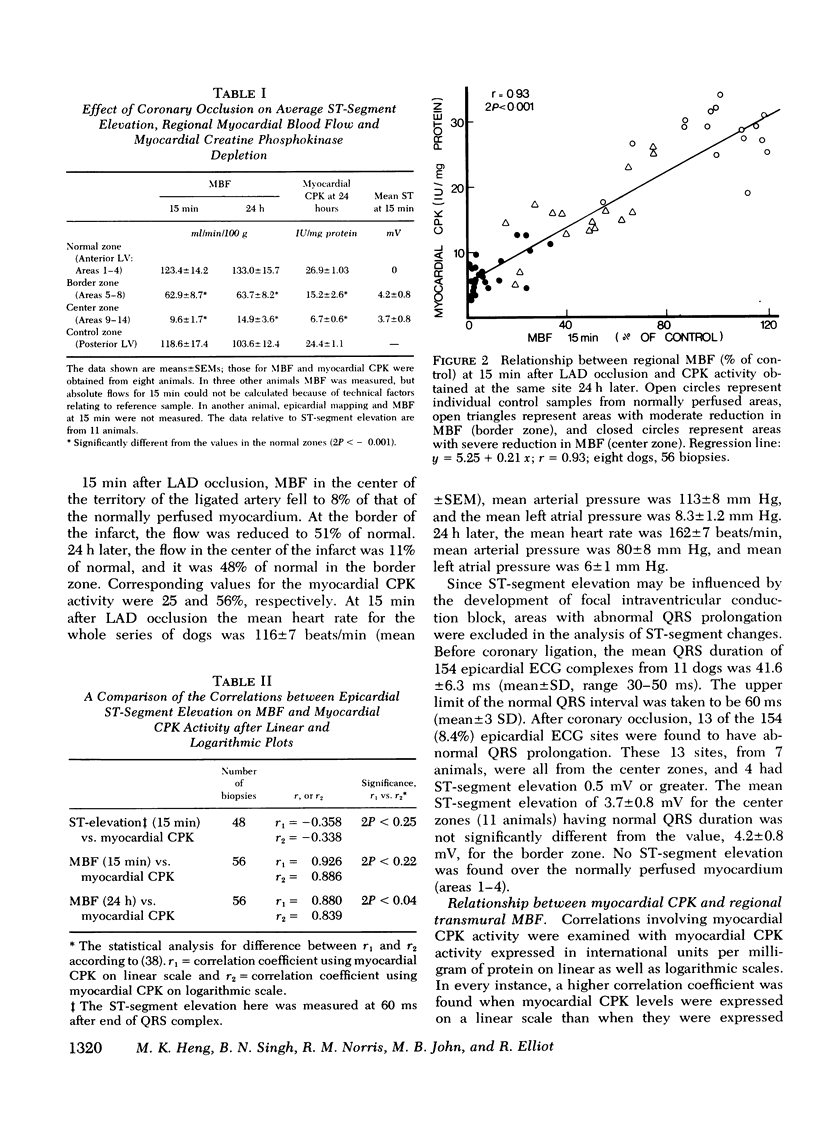


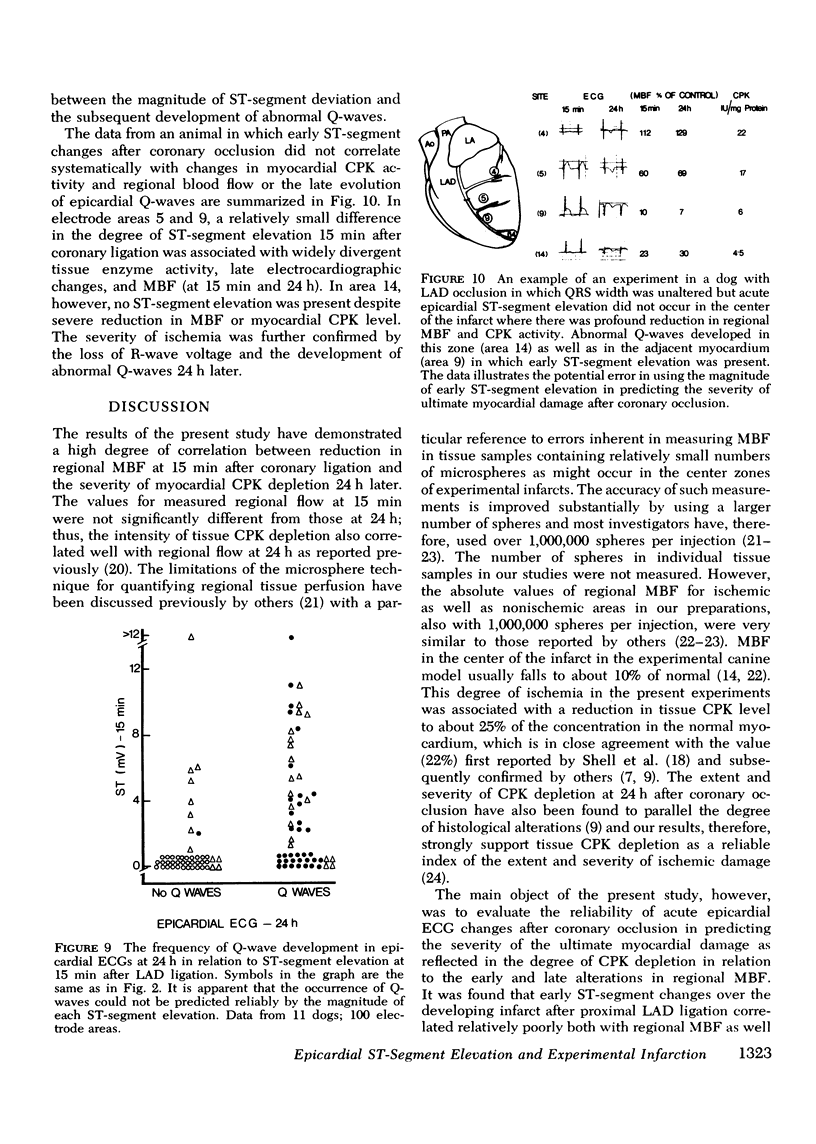
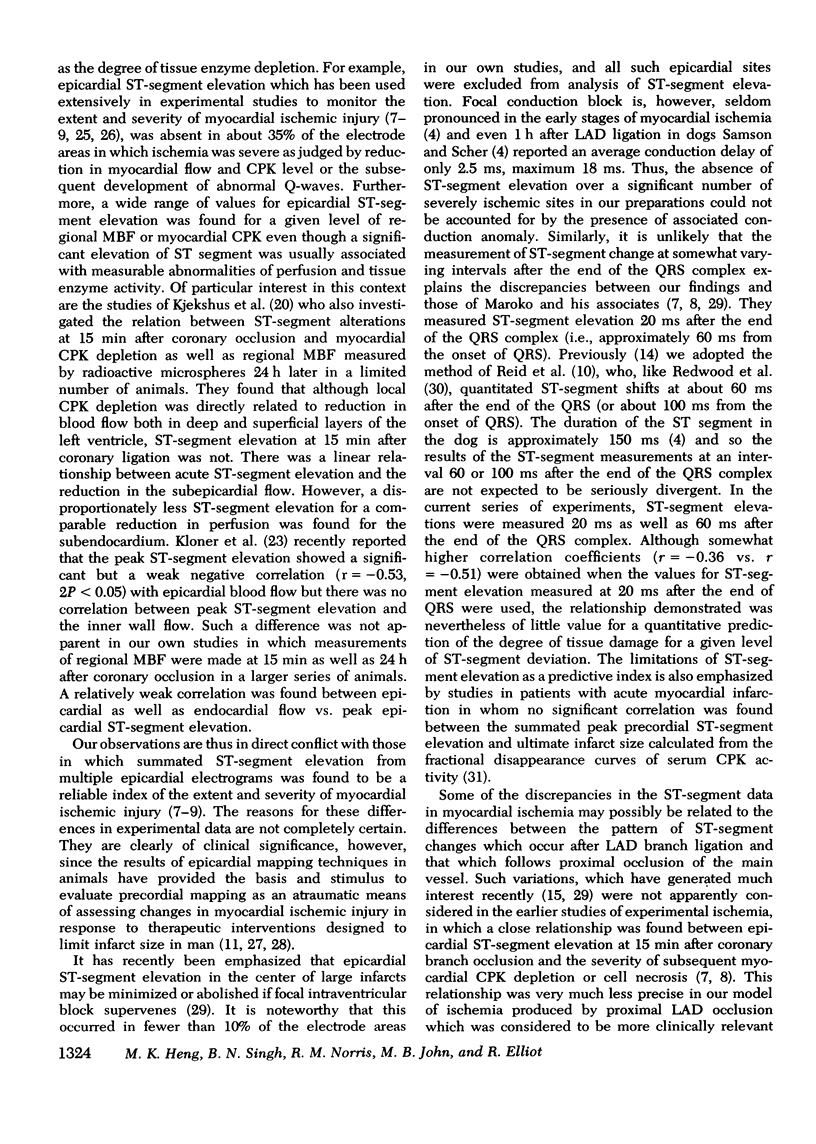
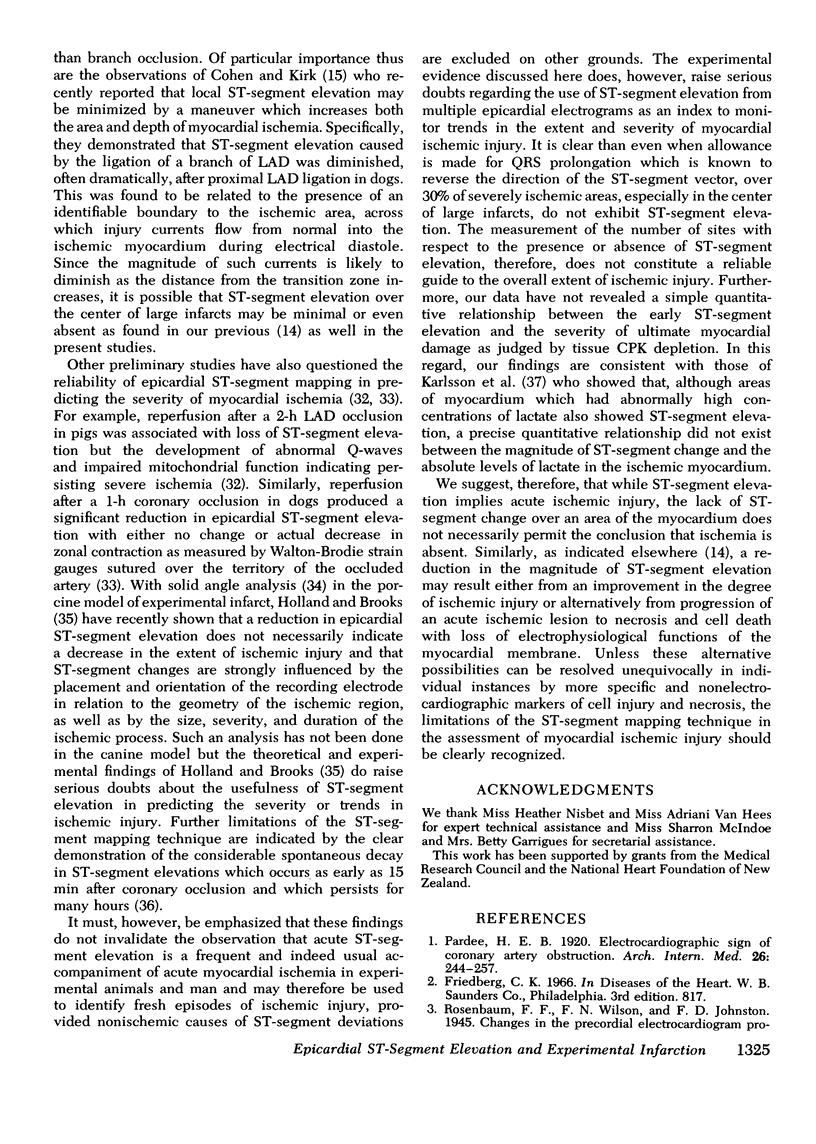
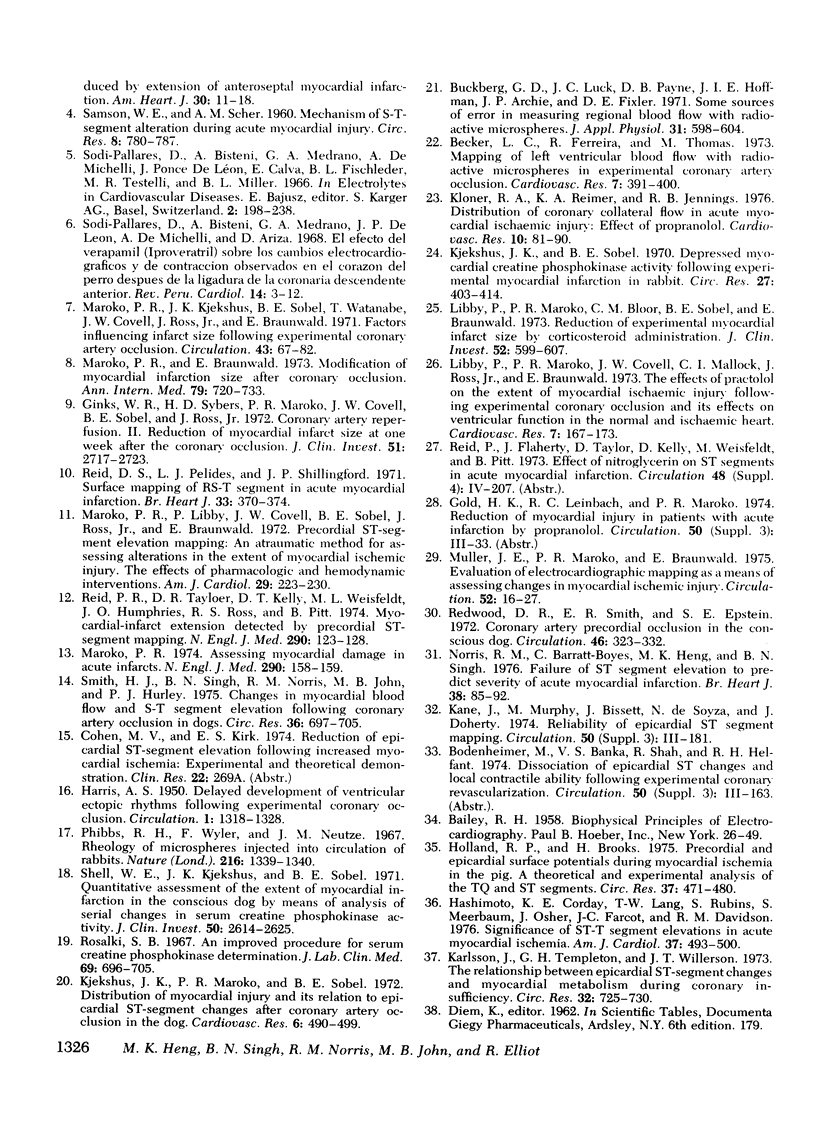
Selected References
These references are in PubMed. This may not be the complete list of references from this article.
- Becker L. C., Ferreira R., Thomas M. Mapping of left ventricular blood flow with radioactive microspheres in experimental coronary artery occlusion. Cardiovasc Res. 1973 May;7(3):391–400. doi: 10.1093/cvr/7.3.391. [DOI] [PubMed] [Google Scholar]
- Buckberg G. D., Luck J. C., Payne D. B., Hoffman J. I., Archie J. P., Fixler D. E. Some sources of error in measuring regional blood flow with radioactive microspheres. J Appl Physiol. 1971 Oct;31(4):598–604. doi: 10.1152/jappl.1971.31.4.598. [DOI] [PubMed] [Google Scholar]
- Ginks W. R., Sybers H. D., Maroko P. R., Covell J. W., Sobel B. E., Ross J., Jr Coronary artery reperfusion. II. Reduction of myocardial infarct size at 1 week after the coronary occlusion. J Clin Invest. 1972 Oct;51(10):2717–2723. doi: 10.1172/JCI107091. [DOI] [PMC free article] [PubMed] [Google Scholar]
- HARRIS A. S. Delayed development of ventricular ectopic rhythms following experimental coronary occlusion. Circulation. 1950 Jun;1(6):1318–1328. doi: 10.1161/01.cir.1.6.1318. [DOI] [PubMed] [Google Scholar]
- Hashimoto K., Corday E., Lang T. W., Rubins S., Meerbaum S., Osher J., Farcot J. C., Davidson R. M. Significance of S-T segment elevations in acute myocardial ischemia. Evaluation with intracoronary electrode technique. Am J Cardiol. 1976 Mar 31;37(4):493–500. doi: 10.1016/0002-9149(76)90387-8. [DOI] [PubMed] [Google Scholar]
- Holland R. P., Brooks H. Precordial and epicardial surface potentials during Myocardial ischemia in the pig. A theoretical and experimental analysis of the TQ and ST segments. Circ Res. 1975 Oct;37(4):471–480. doi: 10.1161/01.res.37.4.471. [DOI] [PubMed] [Google Scholar]
- Karlsson J., Templeton G. H., Willerson J. T. Relationship between epicardial S-T segment changes and myocardial metabolism during acute coronary insufficiency. Circ Res. 1973 Jun;32(6):725–730. doi: 10.1161/01.res.32.6.725. [DOI] [PubMed] [Google Scholar]
- Kjekshus J. K., Maroko P. R., Sobel B. E. Distribution of myocardial injury and its relation to epicardial ST-segment changes after coronary artery occlusion in the dog. Cardiovasc Res. 1972 Sep;6(5):490–499. doi: 10.1093/cvr/6.5.490. [DOI] [PubMed] [Google Scholar]
- Kjekshus J. K., Sobel B. E. Depressed myocardial creatine phosphokinase activity following experimental myocardial infarction in rabbit. Circ Res. 1970 Sep;27(3):403–414. doi: 10.1161/01.res.27.3.403. [DOI] [PubMed] [Google Scholar]
- Kloner R. A., Reimer K. A., Jennings R. B. Distribution of coronary collateral flow in acute myocardial ischaemic injury: effect of propranolol. Cardiovasc Res. 1976 Jan;10(1):81–90. doi: 10.1093/cvr/10.1.81. [DOI] [PubMed] [Google Scholar]
- Libby P., Maroko P. R., Bloor C. M., Sobel B. E., Braunwald E. Reduction of experimental myocardial infarct size by corticosteroid administration. J Clin Invest. 1973 Mar;52(3):599–607. doi: 10.1172/JCI107221. [DOI] [PMC free article] [PubMed] [Google Scholar]
- Libby P., Maroko P. R., Covell J. W., Malloch C. I., Ross J., Jr, Braunwald E. Effect of practolol on the extent of myocardial ischaemic injury after experimental coronary occlusion and its effects of ventricular function in the normal and ischaemic heart. Cardiovasc Res. 1973 Mar;7(2):167–173. doi: 10.1093/cvr/7.2.167. [DOI] [PubMed] [Google Scholar]
- Maroko P. R., Braunwald E. Modification of myocardial infarction size after coronary occlusion. Ann Intern Med. 1973 Nov;79(5):720–733. doi: 10.7326/0003-4819-79-5-720. [DOI] [PubMed] [Google Scholar]
- Maroko P. R. Editorial: Assessing myocardial damage in acute infarcts. N Engl J Med. 1974 Jan 17;290(3):158–159. doi: 10.1056/NEJM197401172900310. [DOI] [PubMed] [Google Scholar]
- Maroko P. R., Kjekshus J. K., Sobel B. E., Watanabe T., Covell J. W., Ross J., Jr, Braunwald E. Factors influencing infarct size following experimental coronary artery occlusions. Circulation. 1971 Jan;43(1):67–82. doi: 10.1161/01.cir.43.1.67. [DOI] [PubMed] [Google Scholar]
- Maroko P. R., Libby P., Covell J. W., Sobel B. E., Ross J., Jr, Braunwald E. Precordial S-T segment elevation mapping: an atraumatic method for assessing alterations in the extent of myocardial ischemic injury. The effects of pharmacologic and hemodynamic interventions. Am J Cardiol. 1972 Feb;29(2):223–230. doi: 10.1016/0002-9149(72)90633-9. [DOI] [PubMed] [Google Scholar]
- Muller J. E., Maroko P. R., Braunwald E. Evaluation of precordial electrocardiographic mapping as a means of assessing changes in myocardial ischemic injury. Circulation. 1975 Jul;52(1):16–27. doi: 10.1161/01.cir.52.1.16. [DOI] [PubMed] [Google Scholar]
- Norris R. M., Barratt-Boyes C., Heng M. K., Singh B. N. Failure of ST segment elevation to predict severity of acute myocardial infarction. Br Heart J. 1976 Jan;38(1):85–92. doi: 10.1136/hrt.38.1.85. [DOI] [PMC free article] [PubMed] [Google Scholar]
- Phibbs R. H., Wyler F., Neutze J. Rheology of microspheres injected into circulation of rabbits. Nature. 1967 Dec 30;216(5122):1339–1340. doi: 10.1038/2161339a0. [DOI] [PubMed] [Google Scholar]
- Redwood D. R., Smith E. R., Epstein S. E. Coronary artery occlusion in the conscious dog. Effects of alterations in heart rate and arterial pressure on the degree of myocardial ischemia. Circulation. 1972 Aug;46(2):323–332. doi: 10.1161/01.cir.46.2.323. [DOI] [PubMed] [Google Scholar]
- Reid D. S., Pelides L. J., Shillingford J. P. Surface mapping of RS-T segment in acute myocardial infarction. Br Heart J. 1971 May;33(3):370–374. doi: 10.1136/hrt.33.3.370. [DOI] [PMC free article] [PubMed] [Google Scholar]
- Reid P. R., Taylor D. R., Kelly D. T., Weisfeldt M. L., Humphries J. O., Ross R. S., Pitt B. Myocardial-infarct extension detected by precordial ST-segment mapping. N Engl J Med. 1974 Jan 17;290(3):123–128. doi: 10.1056/NEJM197401172900302. [DOI] [PubMed] [Google Scholar]
- Rosalki S. B. An improved procedure for serum creatine phosphokinase determination. J Lab Clin Med. 1967 Apr;69(4):696–705. [PubMed] [Google Scholar]
- SAMSON W. E., SCHER A. M. Mechanism of S-T segment alteration during acute myocardial injury. Circ Res. 1960 Jul;8:780–787. doi: 10.1161/01.res.8.4.780. [DOI] [PubMed] [Google Scholar]
- Shell W. E., Kjekshus J. K., Sobel B. E. Quantitative assessment of the extent of myocardial infarction in the conscious dog by means of analysis of serial changes in serum creatine phosphokinase activity. J Clin Invest. 1971 Dec;50(12):2614–2625. doi: 10.1172/JCI106762. [DOI] [PMC free article] [PubMed] [Google Scholar]
- Smith H. J., Singh B. N., Norris R. M., John M. B., Hurley P. J. Changes in myocardial blood flow and S-T segment elevation following coronary artery occlusion in dogs. Circ Res. 1975 Jun;36(6):697–705. doi: 10.1161/01.res.36.6.697. [DOI] [PubMed] [Google Scholar]


